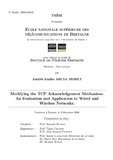| dc.rights.license | http://creativecommons.org/licenses/by-nc-sa/3.0/ve/ | |
| dc.contributor.advisor | Ros, David | |
| dc.contributor.author | Arcia Moret, Andrés Emilio | |
| dc.date.accessioned | 2009-12-03T14:34:39Z | |
| dc.date.available | 2009-12-03T14:34:39Z | |
| dc.date.issued | 2009-12-03T14:34:39Z | |
| dc.identifier.uri | http://www.saber.ula.ve/handle/123456789/31038 | |
| dc.description.sponsorship | Universidad de Los Andes | es_VE |
| dc.description.sponsorship | TELECOM Bretagne | es_VE |
| dc.language.iso | en | es_VE |
| dc.rights | info:eu-repo/semantics/openAccess | |
| dc.subject | Tesis PGCOMP | |
| dc.title | Modifying the TCP Acknowledgement Mechanism: An Evaluation and Application to Wired and Wireless Networks | es_VE |
| dc.type | info:eu-repo/semantics/doctoralThesis | |
| dc.description.abstract1 | Nowadays the Transmission Control Protocol (TCP) is omnipresent in the
Internet. TCP con- veys roughly 90% of the Internet traffic from
applications, such as web, email, file transfers and even multimedia
traffic. In this thesis we develop methods and algorithms to improve the
fundamental working of TCP: the clocking on data packets through the
timely reception of acknowledgements (ACKs). Thus, we study two
complementary aspects on data transmission, i.e., the controlling of the
congestion of ACKs and the accelerating of the ACKs frequency. First, we
describe in detail a mechanism, called ACK congestion control (ACK-CC),
allow- ing TCP to deal with the impairments produced by the congestion of
ACKs in bandwidth asymmetrical networks. Then, we evaluate the functioning
of ACK-CC in both phases of the transmission, namely slow start and
congestion avoidance. On the other hand, for the acceleration of the ACKs
frequency (and thus the acceleration of data transmission) we assess the
ACK division technique, through both simple mathematical modeling and
simulation. In this dissertation we also investigate the performance of
TCP over WiMAX networks. In WiMAX access networks, a Base Station (BS)
serves a number of Subscriber Stations (SSs) forming the so-called
last-mile access. Since the bandwidth management in WiMAX systems is
centralized at the BS, the SSs have to contend for bandwidth to send their
Best Effort traffic (i.e., TCP) in the uplink (from the SS to BS). Hence,
we focus on two particular issues: the impact of the WiMAX MAC-layer
asymmetry on TCP performance, and the improvement of the bandwidth
perception management on the BS to accelerate downlink data transfer. | es_VE |
| dc.description.email | amoret@ula.ve | es_VE |
| dc.description.email | david.ros@telecom-bretagne.eu | es_VE |
| dc.description.grado | Doctor en Informática | es_VE |
| dc.publisher.pais | Francia | es_VE |
| dc.subject.departamento | Departamento de Computación | es_VE |
| dc.subject.escuela | Escuela de Ingeniería de Sistemas | es_VE |
| dc.subject.facultad | Facultad de Ingeniería | es_VE |
| dc.subject.institucion | Universidad de Los Andes | es_VE |
| dc.subject.institucion | TELECOM Bretagne | es_VE |
| dc.subject.keywords | TCP | es_VE |
| dc.subject.keywords | WiMAX | es_VE |
| dc.subject.keywords | ACK congestion control | es_VE |
| dc.subject.keywords | ACK division | es_VE |
| dc.subject.keywords | Bandwidth perception | es_VE |
| dc.subject.postgrado | Doctorado en Informática/Telecomunicaciones | es_VE |
| dc.subject.thematiccategory | Ingeniería | es_VE |
| dc.subject.thematiccategory | Ciencias Computacionales | es_VE |
| dc.subject.tipo | Tesis | es_VE |
| dc.type.media | Texto | es_VE |


